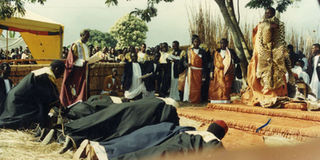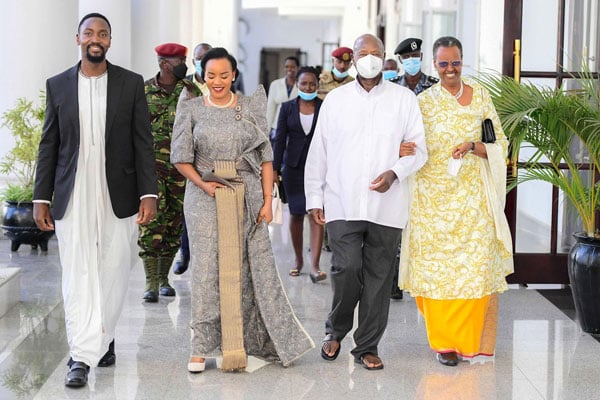1993 Coronation: journey that dates back to 1956

Subjects prostate before Kabaka Mutebi during his coronation in 1993. file photo
What you need to know:
Documents show that Kabaka Edward Muteesa II wrote a will while in London in 1956, saying Prince Ronald Muwenda Mutebi was his heir, and a will was assented to before his witnesses.
On April 3, 1992, the National Resistance Army Council chaired by Lt Gen Yoweri Museveni, sitting in Gulu resolved that; “It has no objection to relevant national authority entering into discussions with the concerned traditional groups with a view to their eventual return or any other mutually acceptable; appropriate arrangement concerning those sites.
“PROVIDED that this does not interfere with the security of the country.”
The purpose of this meeting was to return to the owners all properties that were confiscated by the Obote government in 1966 when it abolished traditional institutions.
This was the symbolic and long-awaited clearance that the Buganda Kingdom had longed for to kick-start the journey to make Prince Ronald Mutebi as the 36th king.
July 24, 1993 was hereafter earmarked as a date for the coronation until the “Pigeon hole” constitution- still operational at the time, hit blow to the entire arrangement.
“Panic engulfed the organisation of the coronation with Article 118 still in place,” recalls Mzee Kayongo Male, one of the architects of the 1993 coronation.
Article 118(1) of the new law, stated thus: “The institution of king or ruler of a kingdom or Constitutional Head of a district, by whatever name called, existing immediately before the commencement of this Constitution under the law then in force, is hereby abolished.”
So against this background, the restoration of a king would not be realised; until the late Abu Mayanja, the then Attorney General and a member of the organising committee, was tasked with the review and remedying of the clause-which took effect on July 23, 1993 and the article was eliminated.
The NRC government equally passed the Traditional Rulers Restitution and Properties Statute - which guaranteed the return of the kingdom property.
“From 1989 when we commenced preparations for the coronation, there was always fierce resistance from individuals like, among others, the now runway spymaster, David Tinyefunza, Dr Kizza Besigye and Maj Gen Mugisha Muntu,” Mzee Kayongo recalls.
He adds: “The realisation of that day in 1993 was preceded by a journey full of sacrifices, patience, backstabbing (from all fronts) and resilience.”
Mutebi nomination
In a book titled- Shaping the Society Christianity and Culture by Pastor Stephen Kyeyune, on August 6, 1956, Kabaka Edward Fredrick Muteesa II, named Prince Mutebi II as the heir, and a will was assented to before his trusted witnesses; I.T.M Sewanyana, Musa K. Parma Ntanda and Robert H. Ntambi Mukasa, in London.
Mutebi is one of Muteesa’s nine children born to Namasole Kabejja Sarah Kisosonkole (RIP) and he is said to have been one-year-old when his father made the will.
According to historical facts at Ugandans at Heart website by K.I. Luts, Muteesa’s will was translated into English on March 3, 1970 by Andrew Frederick Mpanga, who was living in London, with the approval of the then Katikkiro, Joash Mayanja Nkangi.
“Edward Frederick William David Walugembe Mutebi Luwangula Muteesa II of Mengo: This is my will, which I am making in the event of my demise when the Lord pleases to take me away from this world,” Muteesa wrote.
“My child Ronald Frederick Muwenda Mutebi is my heir whom I have chosen to succeed me (to succeed to my Mutuba).”
He, however, clarified that although he was well aware that succession to the throne is decided through election by the Lukiiko, in his will, he wanted to indicate his wish to his people.
“The prince, enumerated in the following order, should be considered first for election: My heir, Ronald Muwenda Mutebi.
Prince Mutebi’s first hand to the throne started with the performing of norm of covering of his father’s body with a bark cloth in 1971 after President Idi Amin allowed the return of his remains from London where he died in 1969.
Prince Mutebi was equally installed as a “Ssabataka” [head of Royal Clans] outside at Bamunanika palace in 1971.
Museveni meets Mutebi
During the 1981 to 1986 Bush War, it noted that Yoweri Museveni, then guerilla commander, met Prince Mutebi, then living in London, in the NRA bush headquarters in Luweero District; at the arrangement of John Nagenda, now Senior Presidential Adviser on media, in an attempt to drum up support for the NRA in the Buganda region.
Although no formal agreement is said to have been made by the two parties, Museveni honoured his promise shortly afterwards despite resistance from his comrades.
Several correspondences indicate that the two similarly held three separate meetings in Masaka, Kilembe and Kabale to conjure the return of monarchism.
“Whether true or not an agreement was signed; the entourages to that meeting have since decided to take the truth with them to the grave,” he adds.
After the war in January 1986, some Baganda elders including Omutaka Grace Musoke and renowned city lawyer John Katende, pushed for the return of the prince from London where he was staying, which the President acquiesced in August.
“All this while preparations for the Coronation were ongoing and brainstorming meetings had started,” Mzee Kayongo narrates. “Other things like the Bika [clan] football tournaments recommenced in 1988 sparking off a wave of unity in the kingdom and some untold hysteria about the prince in waiting.”
He adds that President Museveni was notified hereafter that, these were some of the rituals performed for Prince Mutebi to draw attention from his subjects, “if he was to become a ‘Ssabataka’ in his kingdom.”
“The prince equally remained concerted to issues of his people which did drew less attention of the naysayers.”
Against that backdrop, Mr Museveni allowed the “Ssabataka” to form the first Committee, Ssabataka Supreme Council [SSC] tasked to rally national unity and promote social development.
In late 1992, President Museveni inaugurated discussions between his government and Buganda Kingdom to decide on what possessions to return, when and how.
Mzee Kayongo maintains that in December 1992, Baganda loyalists led by some clan leaders marched through the streets of Kampala as a sign of appreciation to the NRA government for the decision to return the kingdom’s property like cultural sites ordinarily denoted as “ebyaffe”.
The kingdom later concentrated on demanding for most of its property in the subsequent years and a task force led by, among others, Prof Apollo Nsibambi, then minister of Public Service, and Jehoash Mayanja Nkangi, the then Buganda Katikkiro.
The struggle to regain kingdom property is yet to end.
July 31, 1993, was eventually chosen as the day for the coronation of the king at Naggalabi in Wakiso District.




